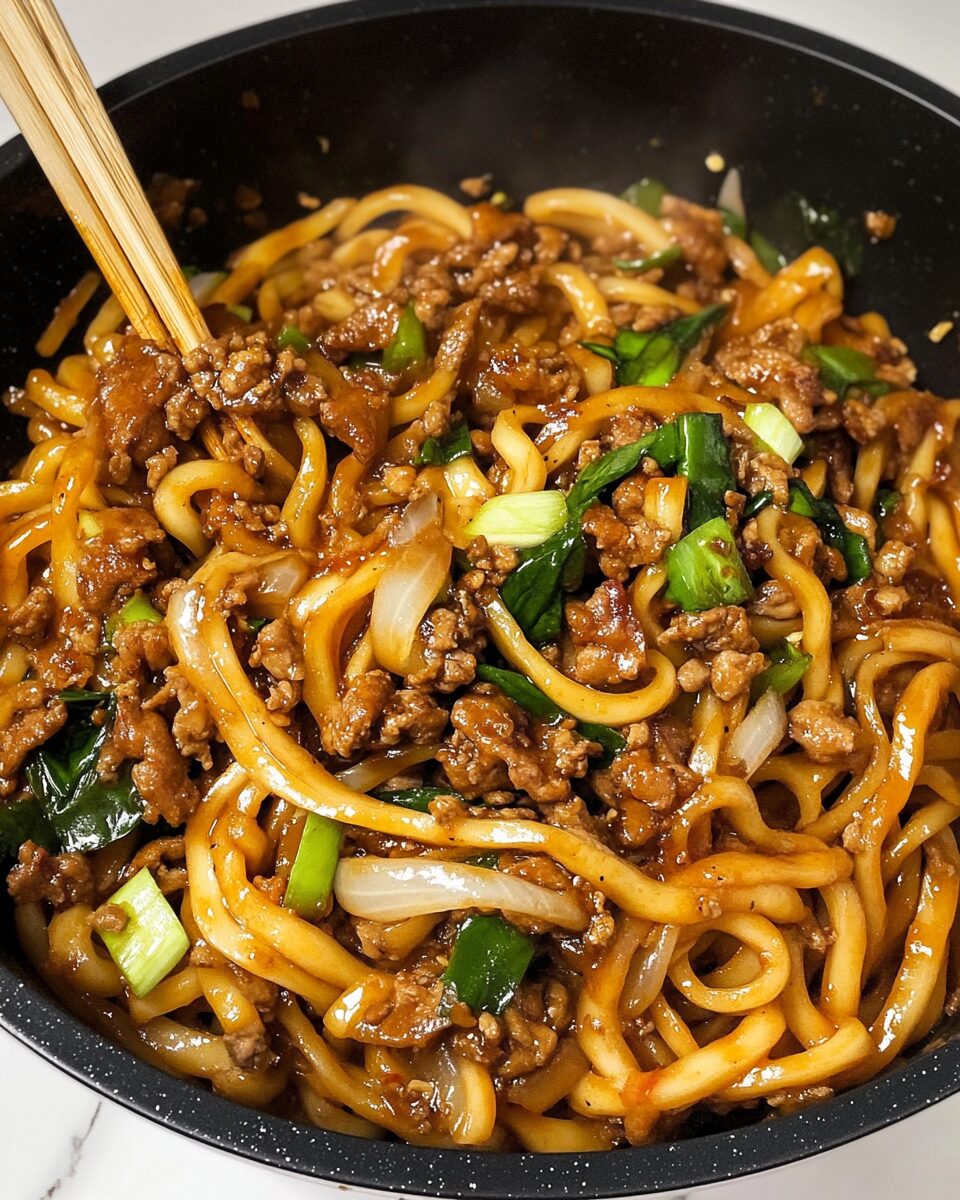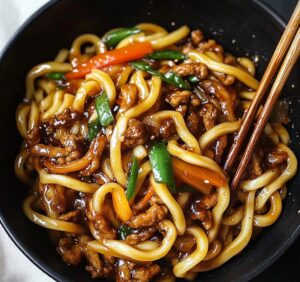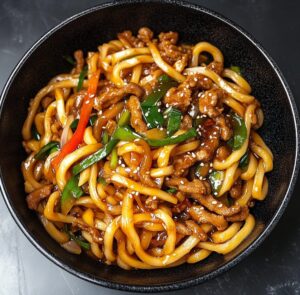The chewy udon noodles soak up a rich soy-based sauce in this classic Japanese stir-fry. Paired with ground pork and a medley of fresh vegetables, every bite is an explosion of umami flavors. The crisp crunch of bok choy and cabbage perfectly balances the savory notes of pork and garlic.
Whether it’s a busy weeknight or a cozy dinner for friends, this dish brings authentic Japanese flavors to your table. Customizable with different meats or a vegetarian twist, this versatile recipe is as comforting as it is delicious. Pair it with a side of miso soup or sushi for a complete Japanese-inspired meal.
Full Recipe:
- 2 tbsp peanut oil or neutral cooking oil
- 2 servings udon noodles (500g)
- 250g ground pork
- ½ medium onion, sliced
- 2 cloves garlic, minced
- 2 cups cabbage, chopped
- 1 carrot, julienned
- 2–3 baby bok choy, chopped
For the Stir-Fry Sauce:
- 3 tbsp soy sauce
- 2 tbsp oyster sauce
- 1 tbsp mirin
- 1.5 tbsp brown sugar
- 1.5 tsp rice wine vinegar
- 1 tsp Gochugaru (Korean chili flakes), optional
Directions:
- Prepare the Sauce: In a bowl, mix soy sauce, oyster sauce, mirin, brown sugar, rice wine vinegar, and Gochugaru. Stir well and set aside.
- Prep Ingredients: Cook udon noodles according to package instructions. Drain and set aside. Julienne vegetables and chop bok choy.
- Cook the Pork: Heat oil in a wok or skillet over medium-high heat. Add ground pork and 2 tablespoons of the sauce. Cook for 4–5 minutes, breaking apart lumps.
- Add Aromatics: Stir in minced garlic and sliced onion. Cook for 1–2 minutes until fragrant.
- Stir-Fry Veggies: Add cabbage and carrot. Toss on high heat for 2–3 minutes until tender but crunchy.
- Combine: Add cooked udon noodles, bok choy, and the remaining sauce. Toss everything for 2–3 minutes on high heat until well coated.
- Serve: Garnish with chopped green onions and toasted sesame seeds, if desired.
Prep Time: 15 minutes | Cooking Time: 10 minutes | Total Time: 25 minutes
Kcal: 333 kcal | Servings: 4 servings
Yaki Udon Noodles Stir-Fry: A Perfect Blend of Flavor and Simplicity
Yaki Udon is a Japanese stir-fried noodle dish that delivers a symphony of flavors in every bite. Known for its chewy texture and neutral taste, udon noodles serve as a versatile base that absorbs the bold, umami-rich flavors of the dish. Originating from Japan, Yaki Udon has grown in popularity worldwide, celebrated for its simplicity, adaptability, and rich taste profile.
A Dish Packed with Umami Goodness
At the heart of Yaki Udon lies its sauce, a balanced blend of soy sauce, oyster sauce, mirin, and rice wine vinegar. These ingredients come together to create a sauce that’s salty, sweet, tangy, and rich in umami. The inclusion of brown sugar adds a touch of sweetness, while the optional Korean chili flakes or Gochugaru can lend a subtle heat for those who enjoy a spicy kick.
Umami, often described as the “fifth taste,” is a defining characteristic of Japanese cuisine. It provides the depth and complexity that makes Yaki Udon so satisfying. This umami-packed flavor is enhanced by the ground pork, which not only adds a savory element but also contributes a hint of natural sweetness. The pork’s ability to evenly mix with the noodles ensures that every bite is infused with flavor.
The Role of Fresh Vegetables
A colorful array of fresh vegetables, such as cabbage, carrot, and baby bok choy, adds both nutrition and texture to Yaki Udon. These ingredients provide a delightful contrast to the soft noodles and tender pork. The crisp crunch of cabbage and the vibrant freshness of bok choy make the dish visually appealing and nutritionally balanced.
The vegetables in Yaki Udon are not only a source of vitamins and fiber but also a canvas for culinary creativity. You can easily customize the dish by incorporating other vegetables like bell peppers, zucchini, or mushrooms, depending on personal preference or seasonal availability. Each vegetable contributes its own unique flavor and texture, enriching the overall eating experience.
Quick, Convenient, and Adaptable
One of the key appeals of Yaki Udon is its simplicity and speed. From start to finish, this dish can be prepared in under 30 minutes, making it an ideal choice for busy weeknights or impromptu gatherings. Despite its quick preparation time, Yaki Udon doesn’t compromise on flavor or quality.
Its adaptability is another reason for its popularity. While the traditional recipe calls for ground pork, you can easily substitute it with other proteins such as chicken, beef, shrimp, or even tofu for a vegetarian option. This flexibility makes it a dish that caters to a wide range of dietary preferences and restrictions.
Cooking Techniques and Tips
Mastering Yaki Udon involves a few simple techniques that elevate the dish. Stir-frying on high heat ensures that the noodles and vegetables retain their texture and don’t become soggy. A large wok or skillet is recommended to provide enough space for tossing the ingredients without overcrowding, which can lead to steaming rather than stir-frying.
Preparation is key when making Yaki Udon. Having all the ingredients prepped and ready before you begin cooking allows you to focus on the stir-fry process, which happens quickly. From chopping vegetables into uniform julienne strips to pre-cooking the noodles and mixing the sauce, a little organization goes a long way in ensuring a smooth cooking experience.
The History and Cultural Significance of Yaki Udon
Yaki Udon is believed to have originated in Japan during World War II. With rice shortages leading to the increased consumption of wheat-based foods, udon noodles became a staple ingredient. The dish was born out of necessity, combining readily available ingredients to create a satisfying and flavorful meal.
Over the years, Yaki Udon has become a beloved comfort food, often enjoyed at home or served as street food in Japan. Its appeal lies in its ability to be both humble and indulgent, a dish that brings people together with its familiar and comforting flavors.
A Nutritional Powerhouse
Beyond its taste, Yaki Udon offers a range of nutritional benefits. The combination of protein, vegetables, and noodles provides a well-rounded meal that is both satisfying and energizing. Udon noodles, made from wheat flour, are a good source of carbohydrates that provide a steady release of energy. When paired with lean protein and fresh vegetables, they form a balanced dish that fuels the body.
For those seeking to make the dish even healthier, whole-grain or low-carb noodles can be used as a substitute. Additionally, reducing the amount of sauce or opting for low-sodium soy sauce can help control the sodium content.
Serving Suggestions and Pairings
While Yaki Udon is a complete meal on its own, it pairs beautifully with other Japanese-inspired dishes. A side of miso soup or a small plate of pickled vegetables can complement the rich flavors of the noodles. For a more elaborate spread, consider serving it alongside sushi rolls, tempura, or grilled teriyaki dishes.
A simple garnish of chopped green onions and toasted sesame seeds not only enhances the dish’s visual appeal but also adds a layer of fresh, nutty flavor. For those who enjoy a bit of heat, a drizzle of chili oil or a sprinkle of red pepper flakes can be added just before serving.
Leftovers and Meal Prep
Yaki Udon is a great dish for meal prep and leftovers. It can be stored in an airtight container in the refrigerator for up to four days. Reheating is a breeze—either in the microwave or with a quick stir-fry in a hot skillet. The flavors often deepen as the dish sits, making it just as delicious, if not more, the next day.
For those looking to freeze Yaki Udon, it’s best to store the noodles and sauce separately to maintain their texture. Thawing the components overnight in the refrigerator and reheating them together ensures that the dish retains its original quality.
Conclusion
Yaki Udon Noodles Stir-Fry is more than just a meal; it’s a celebration of flavor, texture, and tradition. Its versatility and ease of preparation make it a go-to recipe for home cooks looking to recreate the taste of Japanese cuisine. Whether you’re making it for a weeknight dinner, a casual gathering, or simply to satisfy a craving for something savory and comforting, Yaki Udon delivers on all fronts.
From its umami-packed sauce to its colorful medley of vegetables and tender noodles, this dish is a testament to the beauty of simplicity in cooking. As you enjoy Yaki Udon, you’re not just savoring a delicious meal—you’re partaking in a culinary tradition that has stood the test of time.
Print
Yaki Udon Noodles Stir-Fry
- Total Time: 25 minutes
Description
The chewy udon noodles soak up a rich soy-based sauce in this classic Japanese stir-fry. Paired with ground pork and a medley of fresh vegetables, every bite is an explosion of umami flavors. The crisp crunch of bok choy and cabbage perfectly balances the savory notes of pork and garlic.
Whether it’s a busy weeknight or a cozy dinner for friends, this dish brings authentic Japanese flavors to your table. Customizable with different meats or a vegetarian twist, this versatile recipe is as comforting as it is delicious. Pair it with a side of miso soup or sushi for a complete Japanese-inspired meal.
Ingredients
- 2 tbsp peanut oil or neutral cooking oil
- 2 servings udon noodles (500g)
- 250g ground pork
- 1/2 medium onion, sliced
- 2 cloves garlic, minced
- 2 cups cabbage, chopped
- 1 carrot, julienned
- 2–3 baby bok choy, chopped
For the Stir-Fry Sauce:
- 3 tbsp soy sauce
- 2 tbsp oyster sauce
- 1 tbsp mirin
- 1.5 tbsp brown sugar
- 1.5 tsp rice wine vinegar
- 1 tsp Gochugaru (Korean chili flakes), optional
Instructions
- Prepare the Sauce: In a bowl, mix soy sauce, oyster sauce, mirin, brown sugar, rice wine vinegar, and Gochugaru. Stir well and set aside.
- Prep Ingredients: Cook udon noodles according to package instructions. Drain and set aside. Julienne vegetables and chop bok choy.
- Cook the Pork: Heat oil in a wok or skillet over medium-high heat. Add ground pork and 2 tablespoons of the sauce. Cook for 4–5 minutes, breaking apart lumps.
- Add Aromatics: Stir in minced garlic and sliced onion. Cook for 1–2 minutes until fragrant.
- Stir-Fry Veggies: Add cabbage and carrot. Toss on high heat for 2–3 minutes until tender but crunchy.
- Combine: Add cooked udon noodles, bok choy, and the remaining sauce. Toss everything for 2–3 minutes on high heat until well coated.
- Serve: Garnish with chopped green onions and toasted sesame seeds, if desired.
- Prep Time: 15 minutes
- Cook Time: 10 minutes







